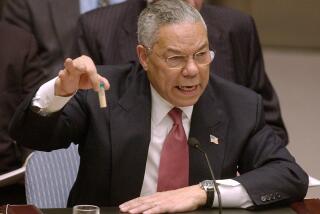Gulf War Offers a Poor Model
- Share via
Several fallacies have found their way into the current debate about the U.S. policy on Iraq. The most popular sees the 1991 Gulf War as a model to be emulated in case of another conflict with Iraq. Proponents of this argument demand that the United States act only under the authority of the U.N. Security Council and as a member of a coalition of like-minded countries.
Such an approach would gain any new American military action political legitimacy, it is argued. Further, the U.S. partners would help defray the cost of the war.
The Gulf War, however, is far from a paragon to be duplicated. According to members of the former Bush administration, the U.S. did not topple Saddam Hussein in 1991 because it sought to abide by the U.N. mandate, which was limited to the liberation of Kuwait. Former President Bush and his aides say they feared any deviation from that mandate would fracture their hard-won coalition.
So it follows that the coalition warfare model of Desert Storm is responsible for leaving Hussein in power and for the fact that the U.S. now must confront him again.
Moreover, since the end of that war, the U.S. effort to sustain the coalition has enabled Russia, China and France to severely dilute the U.N. inspection regime in their efforts to curry favor with the Arab states. Coalition politics also have been responsible for Iraq flouting U.N. resolutions with impunity.
The effort to preserve the coalition allowed Iraq to play its members against one another. As a result, according to a recent CIA report, “key aspects of Iraq’s offensive [biological warfare] program are active and most elements more advanced and larger than before the 1990-1991 Gulf War.”
Regarding the cost-sharing argument of Desert Storm, it is a fallacy to believe that foreign contributions actually alleviated the U.S. expense last time.
According to the Congressional Research Service, the Gulf War cost $61.1 billion, of which 80% was paid by other nations. It must be recalled that after Iraqi forces invaded Kuwait in 1990, oil prices climbed from $15 a barrel to $40 in two months. Prices remained high for more than a year in what many economists saw as a tax on worldwide consumers that allowed Saudi Arabia and Kuwait to pay down the American and allied bill for the war. After all, a $1 increase in oil prices costs U.S. customers an estimated $2 billion a year.
Despite this sorry record, Sen. Carl Levin (D-Mich.), the chairman of the Armed Services Committee, has suggested that Hussein and his commanders would be less likely to use weapons of mass destruction if an international coalition was standing against him.
The senator ought to know better.
In 1991, the coalition warfare model led Hussein to escalate the fighting. He fired Scud missiles into Israel in a calculated attempt to draw the Israelis into the war and thus wreck what the Iraqis termed “the 30-nation aggression.”
This strategy was hardly farfetched. Hussein understood that the Arab participation was meant to contain U.S. war goals.
For example, Hafez Assad, then Syria’s president, put so many conditions on his joining the coalition that the Syrian contingent went virtually unused. In the single instance that it engaged in a military operation, Syrian artillery intentionally overshot its assigned targets.
Nevertheless, for this gallant effort Assad was paid $2 billion by the Saudis, which he promptly used to buy Scud missiles and two missile factories from North Korea.
If Syrian Scuds ever hit U.S. regional targets or Israeli cities, it will be thanks to the coalition warfare model of the Gulf War.
More to Read
Sign up for Essential California
The most important California stories and recommendations in your inbox every morning.
You may occasionally receive promotional content from the Los Angeles Times.













